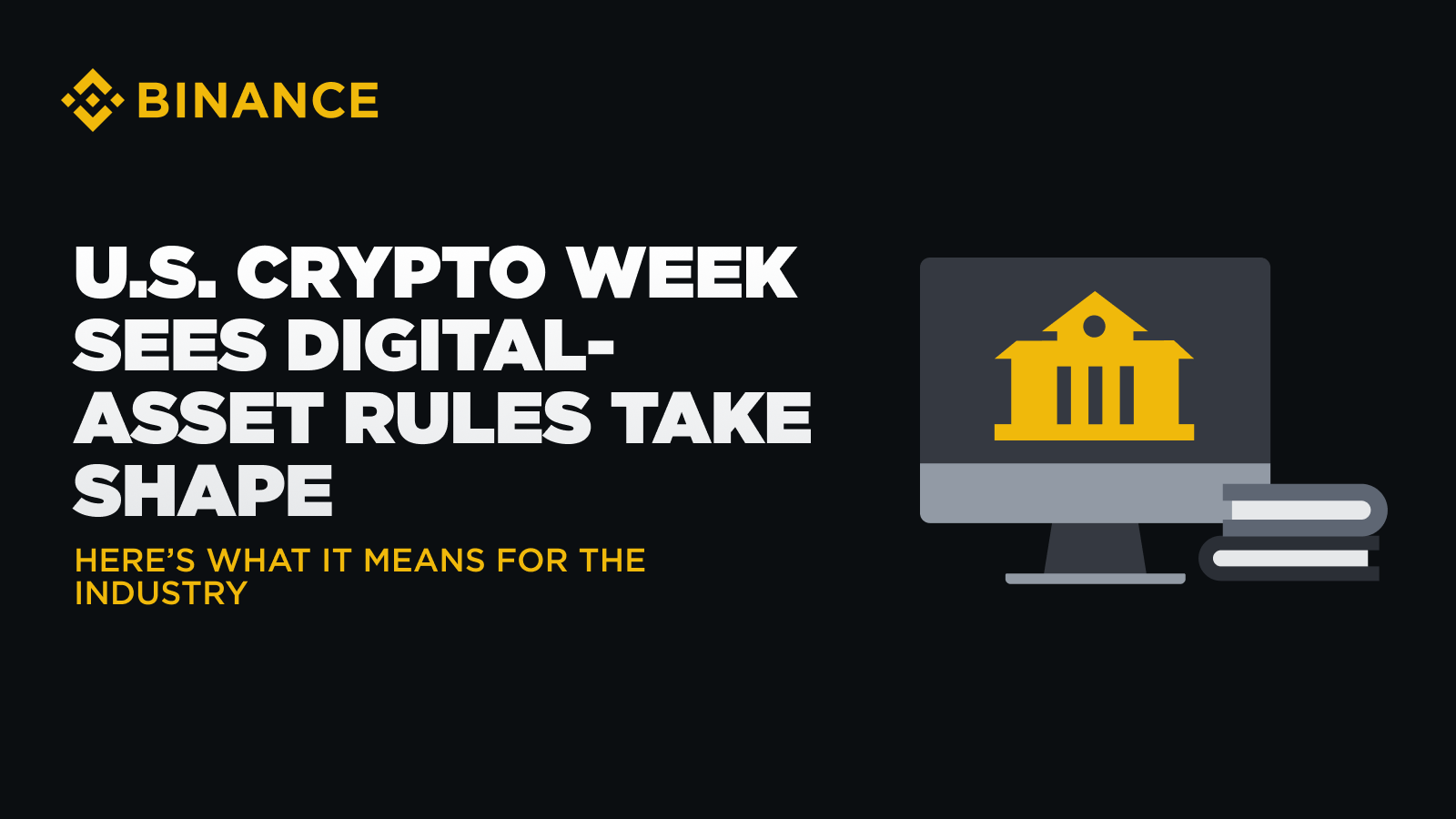Main Takeaways
Last week, U.S. Congress considered three major bills – the GENIUS, CLARITY, and Anti‑CBDC Acts – covering federal rules for stablecoins, token definitions, and central bank digital currency.
The GENIUS Act, signed into law by President Trump on July 18, sets one-to-one reserve requirements, monthly disclosures, and anti‑money laundering guardrails for U.S.-dollar stablecoins. CLARITY and Anti-CBDC passed the House and are headed for the Senate.
Markets responded with enthusiasm: crypto-linked stocks rallied and overall market cap topped $4 trillion, while institutional sentiment turned more positive toward digital assets.
Last week, dubbed "Crypto Week" in Washington, D.C., marked a watershed moment for U.S. digital-asset policy, and a potential turning point for the global crypto ecosystem. Here’s a breakdown of what passed on Capitol Hill, why it matters long-term, how markets reacted, and what Binance’s role could be as legislation finally catches up to innovation.
The GENIUS Act: Federal Rules for Stablecoins
The Guiding and Establishing National Innovation for U.S. Stablecoins (GENIUS) Act sailed through the Senate and passed the House (308-122) on July 17. Signed into law by President Trump on July 18, it's the first standalone federal stablecoin legislation in the United States.
Its key requirements include strict one-to-one backing with U.S. dollars or Treasuries; monthly attested reserve disclosures; clear issuer categories under the Office of the Comptroller of the Currency (OCC) supervision; AML compliance and exclusion of yield-bearing coin operations.
Over time, the Act promises to bolster user trust, facilitate retail stablecoin adoption in everyday payments, and promote stablecoin issuance by banks and certified firms.
The CLARITY Act: Defining Crypto Jurisdiction
Also passed by the House (294-134) was the Digital Asset Market CLARITY Act, charting a much-needed regulatory roadmap for the crypto market. It splits regulatory responsibilities between the Commodity Futures Trading Commission (CFTC) and Securities and Exchange Commission (SEC): crypto token categorization now depends on function and network maturity.
This development follows bipartisan consensus and potentially moves crypto oversight from vague classifications to a structured, long-term framework.
The Anti‑CBDC Act: Rejecting a Federal Digital Dollar
The House of Representatives also passed the Anti-CBDC Surveillance State Act, limiting Federal Reserve power to issue a retail CBDC without legislative approval. This firmly places digital payments in the private sector, supporting innovation via commercial stablecoin models rather than centralized currencies. Similar to the CLARITY Act, it is yet to pass the Senate.
The Senate Picks up the Baton
Hot on the heels of the House, the Senate released their discussion draft of digital-asset market structure legislation on July 22. The draft covers issues under the Banking Committee’s jurisdiction and addresses SEC-related topics only; the Senate Agriculture Committee will be releasing their own draft addressing CFTC-related topics sometime in the near future, with the goal of the two drafts being combined on the Senate floor. The discussion draft builds on the House CLARITY Act and represents the next step in putting a bipartisan regulatory framework on President Trump’s desk.
Market Reaction: Surge in Confidence & Asset Value
Markets responded swiftly: global crypto market cap surpassed $4 trillion for the first time. Bitcoin hit new highs at around $123K, ETH and major altcoins rallied, and stocks of crypto-related firms rose. Companies like Coinbase, Circle, and Ripple gained on expectations of clearer regulation.
What’s Next: Impact and Opportunities
With the GENIUS Act signed into law, stablecoins now have a legal pathway, encouraging use in retail payments, remittances, and business transactions with trust and transparency. Regulatory clarity will also encourage further institutional adoption, as U.S. banks, payment platforms, and exchanges can now build compliant offerings.
For users, it means safer access to digital dollars. For the industry, it’s a clear sign that compliance will unlock opportunity in the world’s largest market.
Final Thoughts
Binance welcomes U.S. bipartisan efforts toward clear, rules-based regulation in the U.S., especially frameworks that build a safe, competitive, and globally interoperable digital-asset market. As a user-first global exchange, Binance already aligns with many of the principles embedded in the CLARITY Act: segregated client assets, transparent disclosures, and strong AML.
We also welcome the advancement of the GENIUS Act and other digital asset-focused bills as catalysts for a safe, secure, decentralized, private-sector-led digital currency ecosystem that ensures consumer protection and market integrity at its heart.
As U.S. leadership continues to shape the global crypto regulatory landscape, Binance remains committed to working with regulators and lawmakers globally to bring compliant, innovative solutions to users worldwide – because shaping the future of finance demands active, credible, and global participation.




